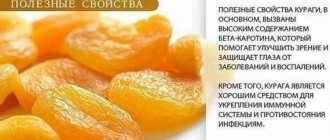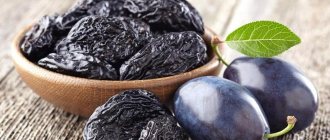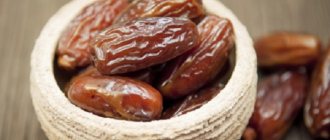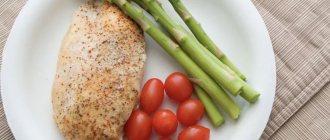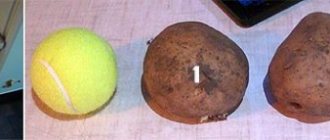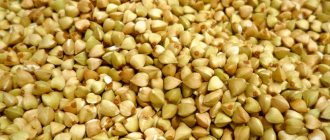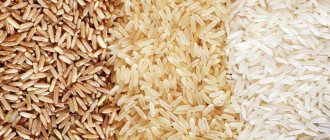Rice: UGC Among the most common types of food on Earth one of the first places is occupied by rice, the calorie content of which is quite high. But it is a dietary product and is included in the daily diet of about half of humanity. Learn about the properties of boiled rice from the article.
Calorie content of rice types
Today, there is such a wide variety of rice varieties on store shelves that it’s dizzying! Among them are basmati, red, steamed white and others.
Calorie content of cereals by type:
| Type of rice | Calorie content, kcal |
| White round grain | 344 |
| Brown | 337 |
| Wild | 357 |
| Red | 362 |
| White long grain | 365 |
| Basmati | 342 |
| White long grain steamed | 341 |
| Air | 402 |
| For sushi | 350 |
Based on the calorie content of different varieties of rice, you can combine a variety of dishes: for example, you can serve fatty fish as a side dish with less high-calorie wild rice, and boiled chicken meat with more high-calorie long-grain rice.
It all depends on the preparation
Photo source: old.st.zakupka.tv
The calorie content of dry grain can differ significantly from a dish prepared from rice. The reason is simple: during cooking, cereals absorb water, oil and other substances. That is why the cooking method directly affects the calorie content of the finished dish. Below is a table showing the varieties of rice with different cooking methods:
| Type of rice | Kcal per 100 g |
| Dry rice | |
| White round grain | 344 |
| Brown | 227 |
| Wild | 101 |
| Red | 362 |
| White long grain | 365 |
| Basmati | 342 |
| White long grain steamed | 341 |
| Air | 402 |
| For sushi | 350 |
| Boiled rice | |
| White round grain | 116 |
| Brown | 110 |
| Wild | 78 |
| Red | 125 |
| White long grain | 127 |
| Basmati | 110 |
| White long grain steamed | 102 |
| For sushi | 281 |
| For a couple | |
| White round grain | 151 |
| Brown | 110 |
| Wild | 100 |
| Red | 148 |
| White long grain | 136 |
| White long grain steamed | 135 |
| Fried rice | |
| White round grain | 188 |
| White long grain | 167 |
| Stewed risk | |
| White round grain | 158 |
| Brown | 115 |
| White long grain | 173 |
| White long grain steamed | 169 |
When adding salt to cereals, during the cooking process, its calorie content becomes higher. So, if the calorie content of white rice boiled in water is 116 kcal per 100 grams, then the calorie content of the same dish with added salt will be about 132 kcal. For other methods of preparing the product, the calorie content of a dish seasoned with salt should be calculated based on the same proportion (approximately +15 kcal per 100 cereals).
Rice with additives
Photo source: https://vtorueblyda.ru
Rice with the additive is no longer a side dish, but an independent dish. By mixing various ingredients to the cereal, you can eat well and varied every day, while getting dishes of vegetarian, Italian, Oriental, Japanese or Russian cuisine.
When preparing multi-component dishes, the total calorie content of the finished dish will be different than that of products prepared separately. When calculating calorie content, we take into account that about 1-5% of oil is added to rice (from the calculated 100 g) and from 20% for other products. Here is an approximate table of the calorie content of ingredients added to rice cereal, as well as the calorie content of the resulting dishes:
| Type of additive | Calorie content, kcal per 100 g of supplement | Ingredient + boiled rice (kcal per 100 g) |
| Oil | 748 | 125 |
| Onion | 43 | 126 |
| Carrot | 37 | 103 |
| Vegetables | 40 | 115 |
| Beef | 197 | 207 |
| Pork | 294 | 137 |
| Chicken | 166 | 133 |
| Ground meat | 286 | 234 |
| Seafood | 112 | 124 |
| Egg | 143 | 94 |
| Cabbage | 28 | 89 |
| Raisin | 267 | 168 |
Despite the high caloric content of oil, the number of calories in the finished dish will not be so high.
This is due to the fact that oil is added to rice from 1 to 5%, and other products - from 20%. When calculating the calorie content of additives, the indicator will vary depending on the method of preparation. So, for example, boiled carrots contain 27 kcal, and fried carrots – 76.
Why include rice in your diet?
Rice is a valuable grain that should be present in the human diet. Being nourishing and healthy, it will benefit the body. The main thing is to observe moderation and not overeat, then it will help get rid of extra pounds and will not cause harm, because the calorie content of boiled rice per 100 grams is no more than 140 kcal. Regular consumption of cereal, due to its absorbent properties, will cleanse the body of waste and toxins and start the metabolism.
Rice has become so firmly established in the modern diet that its exclusion from the menu seems incredible. Useful properties, rich mineral composition and pleasant taste - all this allows everyone to find their favorite variety and prepare a certain dish: sushi, risotto, porridge. Cereals are available to everyone.
Rice dishes
The composition of the dishes no longer includes one or a couple of ingredients, so calculating the calorie content of such dishes is more difficult.
Each housewife has her own secrets and set of ingredients, so we give the approximate calorie content of popular dishes:
| Type of dish | Calorie content, kcal |
| Pilaf | 207 |
| Cabbage rolls with rice | 149 |
| Soup with rice | 54 |
| Cabbage rolls with minced meat and rice | 133 |
| Stuffed pepper | 149 |
| Hedgehogs with rice | 165 |
| Meatballs with rice | 158 |
| Crab salad with rice | 194 |
| Chicken soup with rice | 63 |
Comparing calories
The most popular side dishes among residents of the CIS are boiled white rice, buckwheat and potatoes. Each of these three dishes is healthy and tasty in its own way. Even the cooking time will be approximately the same. The main difference in calorie content of ready-made side dishes:
| Product type | Calorie content, kcal |
| Boiled | |
| Rice | 116 |
| Buckwheat | 114 |
| Potato | 83 |
| Fried | |
| Rice | 188 |
| Buckwheat | 108 |
| Potato | 188 |
| Stewed | |
| Rice | 158 |
| Buckwheat | 132 |
| Potato | 105 |
Rice groats have the highest calorie content, and buckwheat groats have the lowest. Potatoes occupy the middle ground, but they are high in starch. Having set yourself the goal of losing excess weight, you should give preference to buckwheat. Conversely, having decided to make up for the lack of mass, you should eat more rice dishes.
The nutritional value
The calorie content of a product does not provide comprehensive information about its nutritional value. To calculate it, the content of proteins, fats, carbohydrates and other substances in the product must be taken into account. Only by knowing and analyzing all these indicators can you get a clear picture of the usefulness of the product and the need to include it in your diet.
| 100 grams of dry white rice contains: | |
| Squirrels | 7.5 g |
| Fats | 2.6 g |
| Carbohydrates | 62.3 g |
| Alimentary fiber | 9.7 g |
| Water | 14 g |
The need to include rice in the human diet is due to the high content of vitamins and microelements, such as:
- Vitamins: B1, B2, B5, B6, B9, E, H, PP;
- Minerals: K, Ca, Mg, Na, Ph, Cl;
- Microelements: Si, Fe, I, Co, Mn, Cu, Mo, Se, F, Cr, Zn.
Rice is especially noteworthy for its high content of silicon (4133% of daily intake in 100 grams), manganese (182% of daily intake in 100 grams), cobalt and copper (about 50% of daily intake in 100 grams).
Features of the rice diet
If you decide to try rice-based nutrition, you will have to make a lot of effort to endure: tune in emotionally and be patient.
To achieve a visible effect, you need to stay on a diet for 14 days, with the main part of the menu consisting of rice. It is also recommended to add a lot of vegetables and fruits to the diet, small amounts of chicken breast and fish, low-fat kefir and cottage cheese.
The main rule is to cook the cereal in water without salt and sugar, then the calorie content in 100 grams of rice will be the lowest.
The benefits and harms of rice
Rice perfectly energizes and provides a long-lasting resource for the functioning of all systems of the human body. A high percentage of vitamins B and PP has a positive effect on digestion, hair and nails. But these are not all the positive properties of cereals:
- Rice water can coat the walls of the stomach and intestines with a protective film, which makes it an excellent assistant in the fight against stomach and duodenal ulcers .
- The high fiber content in cereals helps normalize intestinal microflora , reducing the risk of developing diabetes.
- The low calorie content of boiled rice without additives allows you to safely include it in the diet of those people who closely monitor their weight .
- Removes toxic substances from the body during intoxication.
- Rice grains do not contain salts, so they can be eaten by people with kidney and gallbladder diseases .
- It contains a large amount of insoluble dietary fiber, which acts as a brush in the body, expelling all decay products, and also preventing the occurrence of cancer cells .
- The cereal contains a small amount of sodium, so people with hypertension can safely use it as food .
- Rice, especially brown rice, contains a high percentage of neurotransmitters that normalize brain function and prevent the development of Alzheimer's and Parkinson's diseases.
- Antioxidants contained in cereals reduce cholesterol levels and stabilize the functioning of the nervous system.
- The product is rich in complex carbohydrates, so it perfectly fights hunger , while leaving you feeling full for a long time.
- It has a mild diuretic effect and helps remove excess fluid from the body . The urinary and diaphoretic effect of rice broth is also useful in the treatment of pneumonia, influenza and sore throat.
- Important substances in the product are tryptophan and lecithin. They accelerate metabolic processes in cells, rejuvenate and heal the human body .
- Rice water helps remove phlegm, so it is recommended to drink for bronchitis and bronchial asthma .
Separately, it is worth noting the additional advantages of eating dishes prepared on the basis of rice cereals:
- reduces stomach acidity;
- improves digestion;
- regulates metabolism;
- cleanses the cardiovascular system and the body as a whole;
- regulates the functioning of the thyroid gland and endocrine system.
Despite the significant list of positive properties, some nutritionists and ordinary people classify rice as harmful foods. About 20 years ago, health workers noticed that China had a high incidence of stomach cancer. This fact was immediately associated with the large volume of rice grain consumed by the Chinese and classified it as a product hazardous to health. Later, scientists conducted a number of additional studies that proved that there is no relationship between cancer diseases and the amount of rice cereal consumed.
Interesting! Rice is considered a hypoallergenic grain and is recommended as one of the first foods for introducing complementary foods to babies. For example, it is recommended to give oat and wheat cereals to children much later.
In the absence of individual intolerance, which is extremely rare, rice cereal is an absolutely safe and edible product for any person. However, here, as elsewhere, moderation is important. The fact is that cereal contains a lot of starch, which can cause decreased intestinal motility and constipation. Systematic constipation, in turn, is fraught with the appearance of bloating, hemorrhoids and heaviness. If you drink water after eating dishes with rice, you can easily avoid such unpleasant moments.
Consumption rate
Important! When choosing a diet, it is worth considering the genetic factor. If your ancestors did not eat rice in large quantities, then you should not base your entire diet solely on this product. It will be enough to eat it 3-4 times a week.
According to Order of the Ministry of Health of the Russian Federation No. 614 dated August 19, 2016 “On approval of recommendations for rational standards of food consumption that meet modern requirements for a healthy diet,” the rate of rice consumption per year per person is 7 kg.
Based on this information, it is easy to calculate that government nutritionists recommend eating 19 grams of rice per day. This measure is too inconvenient, since it is unlikely that anyone will cook in such small portions.
If we translate complex arithmetic into simple everyday language, then the recommendations of the Ministry of Health can be reduced to a simpler formulation. A person, without harm to his health, can consume 1 serving of rice cereal of 150 grams once a week, and in addition to this, add cereal to dishes where it is not the main ingredient, for example, stuffed peppers with meat and rice, hedgehogs, and so on .
What are the beneficial properties of this product for human health?
As a rule, rice cereals are represented by oval or elongated grains. This is one of the universal products that helps maintain and restore the strength of the human body.
As mentioned earlier, the health benefits and harms of rice are related to the chemical composition and nutritional characteristics. This section will discuss the first indicator.
Regular consumption of this product promotes good functioning of the digestive system, despite the fact that it is “heavy”. This is due to the effect of dietary fiber. The content of these components in rice is about half of the required daily requirement. Dietary fiber has a cleansing and stimulating effect on the intestines. This fibrous mass acts as a brush. It collects and removes all toxins from the body, and then gently massages the walls of the organs. This helps improve blood supply.
Rice also contains a large amount of potassium. It is responsible for controlling water-salt balance. Rice porridge with milk is very useful for diseases of the joints, kidneys and intestinal problems.
Another advantage of this product is that it is gluten-free. This component contributes to the occurrence of an allergic reaction in young children. Therefore, rice porridge is considered safe for babies. In addition, it is useful for lactating women, since regular consumption of this crop promotes lactation.
Another fact, unproven scientifically, according to the Japanese, is that rice has a beneficial effect on brain activity and the nervous system. There is still partial confirmation by scientists. This is due to the presence of lecithin in rice.
How to choose the right rice
Photo source: https://orebenke.info
The health benefits and taste characteristics of rice dishes directly depend on the quality of the raw materials. The fresher the rice grain, the more beneficial it is for the body, and the more conscientious the manufacturer, the more stages of purification from impurities the product has gone through. A few simple tips will help you avoid mistakes when choosing cereals:
- Attention to packaging
First of all, the packaging must be inspected for integrity: check for signs of opening, re-sticking of the label or resoldering of the packaging seams.
Any packaging must contain information about the manufacturer and date of manufacture.
If the cereal was packaged from a large container, then the consumer packaging must contain data on the date of packaging. It’s a good sign if GOST is on the packaging.
Any packaging must be clean, not torn, without traces of dust and dirt. A careless attitude towards the container can lead to the fact that when opened, all microbes will immediately end up in the product itself and on your kitchen table.
- Looking for impurities
Be sure to shake the bag a couple of times in different planes and inspect it for impurities: grains that differ in color and size, larvae, sand, insects, dry grass, and so on. The presence of impurities of plant origin indicates the dishonesty and low culture of the manufacturer.
If you find traces of the presence of insects, larvae, etc., you should immediately refuse to purchase this product, as it may be hazardous to health. You can report such a product to the store manager or salesperson so that they can immediately remove it from the shelf.
- My years are my wealth
This phrase applies only to basmati, which, when properly stored, only becomes more aromatic and tastier, but it cannot be stored for longer than 18 months. All other varieties of rice lose their consumer properties during storage and become less healthy. Other types of cereals can be stored for 16 to 18 months, so you should carefully pay attention to the production date indicated on the product. Otherwise, it may turn out that a product purchased for future use will turn out to be unsuitable for consumption in a month.
When purchasing rice cereal, you should give preference to trusted manufacturers whose products you have already tried and were satisfied with. If you decide to purchase a new brand, do not rush and treat the whole family to this rice; it is better to first prepare a small portion for testing.
A little history
Rice is the oldest agricultural crop, as evidenced by numerous archaeological finds, entries in ancient books, ancient schemes of fields and irrigation systems.
The homeland of this cereal is the territory of modern countries of Southeast Asia - Vietnam, Thailand. Its cultivation in these areas dates back to the seventh century BC. This culture then spread to China and India. Archaeological research indicates the cultivation of rice in the sixth century BC. Gradually, the cultivation and use of cereals spread to the lands of Japan and Korea, where it became the main food product of the population.
On the African continent, another type of cereal was grown - “naked” rice, which was cultivated from the 4th or 5th century BC on the banks of the Nile. True, at present this type of grain is not grown industrially; it has been supplanted by its Asian counterpart.
Rice came to European countries after the military campaign of Alexander the Great. The ancient Romans and Greeks brought it from Asian countries. The product was expensive and was used only for medical purposes.
The first rice fields appeared in Italy in Pisa in 1468. Rice in Europe gained popularity during the plague of the 13th century, when for the first time a less labor-intensive crop, rice, began to be cultivated instead of wheat. Since then, the nutritional value of rice and its taste have been appreciated.
Rice and diet
The low calorie content of rice has led to its frequent use in various diets. Some of them promise to get rid of 10 extra pounds in just one week.
Important! Mono-diets based on eating only one food product can harm the body. Having given preference to this method of normalizing weight, you should additionally nourish the body with multivitamins. Only a doctor will help you create a competent diet after studying your tests and health status.
Rice diet
This diet is monocomponent. The entire diet of someone losing weight consists of this grain, and there are two types of such a diet: soft and hard.
Photo source: https://appetitno.net
- When choosing a strict weight loss regimen, pour a glass of rice grain in the evening with two glasses of cold boiled water. Over the course of the morning, the rice swells and becomes soggy, resulting in something like porridge. The resulting portion of porridge should be divided into five doses and you should eat it exclusively all day. It is worth noting separately that you cannot add sugar, salt, pepper, honey and other ingredients to the porridge.
- A milder scheme involves eating rice grains for breakfast, lunch and dinner with various additives.
For breakfast, you can eat rice porridge in water with an apple, orange or grapefruit.
For lunch, boiled rice with stewed mushrooms, stewed carrots or boiled broccoli is suitable. For dinner, you can treat yourself to rice with steamed vegetables, cucumber salad or Greek yogurt. Both diets are considered quite severe, so you should not stick to them for more than five days. These options are perfect for quickly getting yourself in order before an important event, such as a wedding.
Important! When choosing a rice diet, the rate of consumption of clean water per day is at least 2 liters.
Buckwheat-rice diet
Rice and buckwheat complement each other perfectly, since both grains contain a large amount of complementary nutrients. Such a diet is much easier to tolerate than a monocomponent diet, although its effectiveness is no less.
Photo source: https://chudo-dieta.com
The buckwheat-rice diet lasts 5 days, the diet of each of which is built on the same principle:
- Breakfast – a couple of fruits;
- Lunch – rice porridge with mixed nuts;
- Afternoon snack – fresh vegetable salad;
- Dinner – boiled buckwheat with boiled chicken breast or steamed fish.
For a snack, you can eat a portion of low-fat cottage cheese without sour cream and without sugar.
Rice and honey diet
This is another strict monocomponent diet, which you should not stick to for longer than 5-7 days. This diet is less dangerous than others, as it contains honey, a storehouse of nutrients.
Photo source: https://www.patee.ru
Attention! The rice-honey diet is contraindicated for those who are allergic to honey and bee products.
The essence of the diet is that the entire diet consists of two elements:
- 500 grams of rice porridge, which is eaten in five meals.
- 250 ml of honey drink with lemon, which is drunk in three doses.
Other products cannot be added.
Geisha diet
When you hear the word “geisha,” your imagination immediately draws an image of a miniature, thin woman, almost transparent and immensely charming. They achieved their chiseled forms by periodically adhering to a certain diet:
- Breakfast – 0.5 liters of green tea with the addition of 50 ml of milk;
- Lunch – 250 grams of boiled brown rice with 0.5 liters of green tea;
- Dinner – 250 grams of boiled brown rice with 0.5 liters of green tea.
Photo source: https://geishaofjapan.com
Such a diet can last from three to seven days without harm to the body. During this time, not only the extra centimeters are lost, but also the skin color improves, fine wrinkles are smoothed out and your well-being improves.
Comparing the calorie content of dishes
| Diet rice with chicken | Diet rice with vegetables and shrimp |
| Nutritional value per 100 g: Calories: 102 kcal. Proteins: 11 gr. Fats: 0.7 gr. Carbohydrates: 14.2 g. | Nutritional value per 100 g: Calories: 86 kcal. Proteins: 6 gr. Fats: 0.4 gr. Carbohydrates: 16 gr. |
conclusions
In the absence of contraindications, rice cereal can be considered a uniquely healthy product.
You should definitely include it in your diet at least once a week, especially since it is recommended by the Russian Ministry of Health. A variety of cooking options: rice with onions and butter, with meat (chicken, beef or pork), pies with rice, lazy cabbage rolls - will make each dish made from this cereal unique and special. The low calorie content of the product allows those who are on a diet to eat it without fear. An additional advantage of cereal is that there are many varieties of it, brought from different parts of the world, so it will not be difficult for every resident of the CIS to choose rice to suit their taste and budget.
Contraindications
Despite all the positive qualities, the product has a number of contraindications:
- it should not be given to people with extreme obesity;
- persons with urolithiasis;
- those who have slow or difficult bowel movements (gastric emptying);
- suffering from atherosclerosis;
- diabetics, during exacerbation of the disease;
- infants up to 7 months;
- rice dishes with meat are difficult for the digestive system to process;
- individual intolerance.
When buying rice in a store, pay attention to whether it is indicated on the packaging that it has passed toxicological control. If such information is indicated, it means that arsenic was not used in growing the cereal. If you buy white rice, there should be no yellow grains in the package.
If they are present, it means that before packaging the product was stored in conditions of high humidity; it is in such an environment that fungus and mold can develop. You shouldn’t take such a pack to avoid getting sick.
Features of eating rice for certain diseases
The product is one of the safest and rarely causes harm even with chronic ailments. But in order for rice to be beneficial, you need to know how to take it for various ailments.
For diabetes
White refined rice has a fairly high glycemic index - as much as 70 units. Therefore, if you have diabetes, it is better not to use it. Moreover, it is believed that the properties of the product can negatively affect health if you are prone to diabetes and even cause the development of the disease.
But the benefits and harms of brown rice for diabetics are in a different ratio - the positive effect of brown grains on the body is much greater. The glycemic index of brown rice is lower and equal to only 50 units, while the product has a good effect on metabolism, helps lower blood glucose levels and protects against complications.
For pancreatitis
For inflammation of the pancreas, white rice is beneficial. Moreover, its valuable properties appear not only during the period of remission, but also in the acute phase; the product can be eaten within 3 days after the acute pain subsides.
In order for the benefits and harms of boiled rice for pancreatitis to have a beneficial effect on the body, the cereal must be processed as carefully as possible - not only boiled, but also pre-chopped. Milk porridges, puddings and vegetable soups will be healthy.
Important! In the acute phase of the disease, only polished white rice is allowed to be consumed. Unrefined varieties can be used during remission, but as rarely as possible.
For gastritis and ulcers
The benefits and harms of polished rice are appreciated for irritated stomach mucous membranes - during gastritis and ulcers, you can eat cereals. Before cooking, rice must be thoroughly soaked to soften it and thoroughly cooked.
Eating rice for gastritis will not cause harm only if there is no tendency to constipation - the product has fixing properties.

